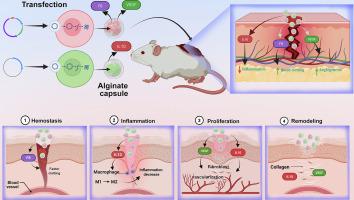用于糖尿病伤口全面快速修复的工程化细胞止血水凝胶
IF 13.2
1区 工程技术
Q1 ENGINEERING, CHEMICAL
引用次数: 0
摘要
糖尿病伤口复杂的微环境,以持续炎症、血管生成受损和止血受损为特征,严重延迟了愈合,并提出了重大的临床挑战。目前的治疗方法往往缺乏有效解决这些相互交织的病理所需的多方面方法。在此,我们提出了一种新的基于细胞的治疗平台:海藻酸盐水凝胶包裹的精确工程人胚胎肾(HEK 293T)细胞,设计用于糖尿病伤口修复和肝脏止血。HEK 293T细胞通过PiggyBac转座子系统稳定地表达促血管生成的人血管内皮生长因子a (hVEGFA)、止血因子VIII (hFVIII)和免疫调节白介素-10 (hIL10),确保这些治疗因子的持续分泌。体外研究证实了hvegfa介导的细胞迁移和伤口愈合的升高,hFVIII刺激血液凝固的加速,以及hIL10作为一种有效的抗炎减少氧化应激的作用。hVEGFA、hFVIII和hIL10的组合在体外和体内创面愈合方面均取得了显著的优势。在糖尿病大鼠全层切除伤口模型中,给药这些工程细胞负载水凝胶可显著加速伤口在2 周内愈合。此外,细胞分泌的hFVIII在体外和肝脏穿刺模型中与人血液混合时显示出显著的止血效果,减少了体内活化的部分凝血活素时间、失血量和凝血时间。另一方面,胶囊在长期内没有表现出任何异种效应和免疫原性。这种基于细胞的多功能水凝胶系统为糖尿病伤口快速愈合的体内平衡快速衰减提供了一个全面而有前途的平台。本文章由计算机程序翻译,如有差异,请以英文原文为准。

Engineered cell-laden hemostatic hydrogels for all-round rapid repair of diabetic wounds
The complex microenvironment of diabetic wounds, characterized by persistent inflammation, impaired angiogenesis, and compromised hemostasis, severely delays healing and presents a significant clinical challenge. Current therapies often lack the multi-faceted approach required to address these interwoven pathologies effectively. Herein, we present a novel cell-based therapeutic platform: precision-engineered human embryonic kidney (HEK 293T) cells encapsulated within alginate hydrogels, designed for diabetic wound repair and liver hemostasis. HEK 293T cells are stably engineered via a PiggyBac transposon system to co-express pro-angiogenic human Vascular Endothelial Growth Factor A (hVEGFA), hemostatic Factor VIII (hFVIII), and immunomodulatory Interleukin-10 (hIL10), ensuring sustained secretion of these therapeutic factors. In vitro studies confirmed hVEGFA-mediated elevation of cell migration and wound closure, hFVIII stimulated acceleration of blood clotting, and hIL10's role as a potent anti-inflammation reducing oxidative stress. A combination of hVEGFA, hFVIII, and hIL10 notably achieved superior in vitro and in vivo wound healing. In a diabetic rat full-thickness excisional wound model, administration of these engineered cell-laden hydrogels significantly accelerated wound closure within 2 weeks. Furthermore, cell-secreted hFVIII demonstrated remarkable hemostatic efficacy when mixed with human blood ex vivo and in a liver puncture model, reducing activated partial thromboplastin time, blood loss, and clotting time in vivo. On the other hand, capsules did not show any xenogeneic effect and immunogenicity in the long term. This multi-functional cell-based hydrogel system offers a comprehensive and promising platform for rapid attenuation of homeostasis for rapid diabetic wound healing.
求助全文
通过发布文献求助,成功后即可免费获取论文全文。
去求助
来源期刊

Chemical Engineering Journal
工程技术-工程:化工
CiteScore
21.70
自引率
9.30%
发文量
6781
审稿时长
2.4 months
期刊介绍:
The Chemical Engineering Journal is an international research journal that invites contributions of original and novel fundamental research. It aims to provide an international platform for presenting original fundamental research, interpretative reviews, and discussions on new developments in chemical engineering. The journal welcomes papers that describe novel theory and its practical application, as well as those that demonstrate the transfer of techniques from other disciplines. It also welcomes reports on carefully conducted experimental work that is soundly interpreted. The main focus of the journal is on original and rigorous research results that have broad significance. The Catalysis section within the Chemical Engineering Journal focuses specifically on Experimental and Theoretical studies in the fields of heterogeneous catalysis, molecular catalysis, and biocatalysis. These studies have industrial impact on various sectors such as chemicals, energy, materials, foods, healthcare, and environmental protection.
 求助内容:
求助内容: 应助结果提醒方式:
应助结果提醒方式:


